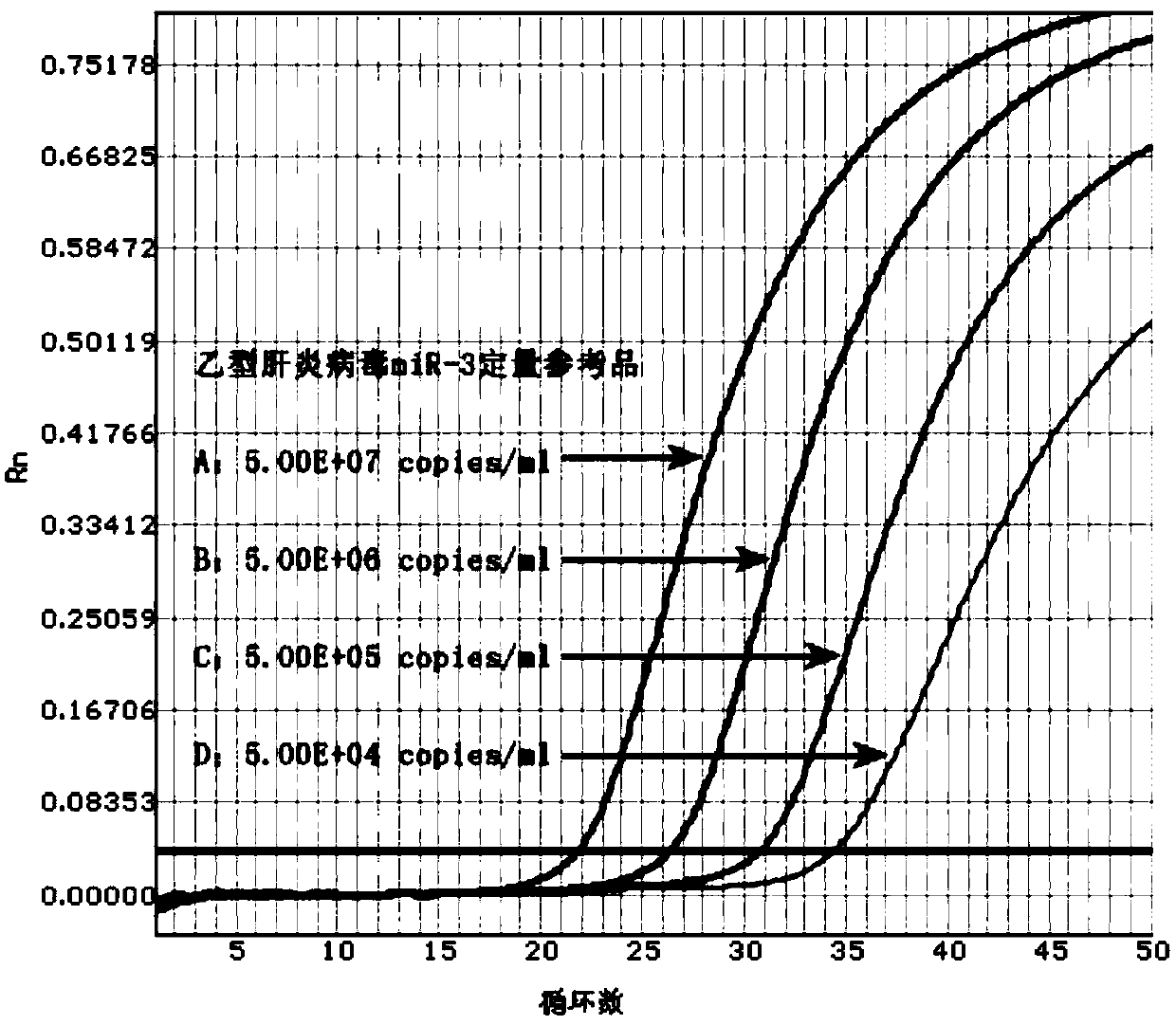Hepatitis B virus miR-3 and human liver specific miR-122 triple fluorescent quantitative PCR detection kit
A hepatitis B virus, fluorescence quantitative technology, applied in medical detection and biological fields, can solve the problems of inability to absolutely quantify serum microRNA molecule copy concentration, low efficiency of single-color fluorescence PCR, etc., to achieve the existence of monitoring false negatives and good specificity , the effect of improving efficiency
- Summary
- Abstract
- Description
- Claims
- Application Information
AI Technical Summary
Problems solved by technology
Method used
Image
Examples
Embodiment 1
[0063] Example 1.microRNA extraction
[0064] (1) Take 100 μl of serum / plasma and add it to a 1.5ml centrifuge tube, add 0.5ml of Trizol reagent to each tube, pipette the tip repeatedly to mix until the protein is completely dissolved, add 5 μl of 5nmol / L internal reference to each tube, mix well, and place at room temperature for 10 minute.
[0065] (2) Add 100 μl of chloroform to each tube, shake vigorously for 15 seconds, and place at room temperature for 3 minutes.
[0066] (3) Centrifuge at 12000×g for 15 minutes at 4°C, pipette 0.3ml of the supernatant into a new 1.5ml centrifuge tube, add 0.3ml of isopropanol, mix well, and let stand at room temperature for 10 minutes.
[0067] (4) Put the small molecule RNA adsorption column in a 2ml collection tube, transfer all the RNA isopropanol mixture to the small molecule RNA adsorption column, and centrifuge at 8000×g for 1 minute.
[0068] (5) Discard the filtrate, put it back into the column, add 0.5ml washing solution 1 to...
Embodiment 2
[0070] Example 2. microRNA reverse transcription
[0071] (1) Take 8 μl of 2.5×reverse transcription mixture and 0.5 μl of 10 μmol / L reverse transcription primer mixture into a 0.2 ml RNase-free PCR thin-walled tube. (wherein the 10 μmol / L reverse transcription primer mixture is a mixture of miR-3, miR-122 and C.elegansmiR-39 reverse transcription primers, and the concentration of the three is 10 μmol / L)
[0072] (2) Add 11.5 μl of the extracted microRNA into the above mixture, and mix well by pipetting.
[0073] (3) Put it into a PCR machine for reverse transcription, the conditions are: 42° C. for 30 minutes, 70° C. for 5 minutes. The obtained cDNA was stored in an ice box for later use.
Embodiment 3
[0074] Example 3. Triple fluorescent quantitative PCR
[0075] (1) Take 25 μl of 2×PCR mixed solution, 5 μl of 2 μmol / L probe mixed solution, and 15 μl of deionized water into a 0.2 ml 8-section PCR tube. (The 2 μmol / L probe mixture is a mixture of miR-3, miR-122 and C.elegans miR-39 probes, and the concentration of the three is 2 μmol / L)
[0076] (2) Add 5 μl of reverse transcribed cDNA to each tube and mix well.
[0077] (3) Put the PCR reaction tube into the fluorescent quantitative PCR amplification instrument, and set the name of the sample to be tested and the concentration of the quantitative reference product in the corresponding order
[0078] (4) Selection of fluorescence detection channel: FAM channel was selected to detect miR-3 by software, HEX was selected to detect internal reference, and Cy5 channel was selected to detect miR-122.
[0079] (5) The reaction conditions of fluorescent quantitative PCR are: 95° C. for 3 minutes, enter cycle: 95° C. for 12 seconds...
PUM
 Login to View More
Login to View More Abstract
Description
Claims
Application Information
 Login to View More
Login to View More - R&D
- Intellectual Property
- Life Sciences
- Materials
- Tech Scout
- Unparalleled Data Quality
- Higher Quality Content
- 60% Fewer Hallucinations
Browse by: Latest US Patents, China's latest patents, Technical Efficacy Thesaurus, Application Domain, Technology Topic, Popular Technical Reports.
© 2025 PatSnap. All rights reserved.Legal|Privacy policy|Modern Slavery Act Transparency Statement|Sitemap|About US| Contact US: help@patsnap.com



